Predictably the crises of climate change and the pandemic highlighted deficits in health services, markets, welfare and education. Both have accelerated a predictable economic recession.
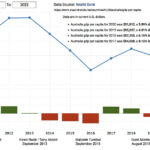
To understand the early signs of an economic downturn, we need to go back to when politically acknowledged signs of a faltering economy appeared. The GDP downturn in the third quarter of 2016 was preceded by nearly three years of a per-capita recession. The retail boom of the last quarter (Christmas) saved us from an official recession. However, by the end of 2018, Australia re-entered a per-capita recession. “Australia’s economic output shrank 0.2pc per person in the fourth quarter of 2018, after a 0.1pc decline in the third”. By mid-2019, economists predicted a recession as employment growth was slow, unemployment high, and wages were stagnating. Then, by the end of 2019, as Australia was literally burning down due to climate change, a global pandemic hit, and the pack of cards came tumbling down, and the recession we were always going to have, hit us.
OUR STROLLOUT
The political response to the health crisis, lockdowns, quarantine handling, welfare support, vaccine strollouts has been underwhelming. Yet despite Government mismanagement, we moved from the least vaccinated nation in the OECD to a position by early November 2021 with 80% vaccination rates. Although we still had thousands of active cases, hundreds of newly acquired cases and hundreds in hospital. It isn’t over, but considering the state of other Western countries, we could be worse off.
The Federal Government celebrated some States opening up and criticising those that did not. Our Treasurer, Josh Frydenberg, had been spruiking our “recovered” unemployment numbers as the ABS claimed we had unemployment around five per cent. However, despite apparently rising job vacancies and falling unemployment (relative to 2020), business sector elements have complained that they can not find staff to fill jobs on offer.
ZERO-HOURS
So let’s explore the nuances of these circumstances where businesses claim they cannot fill vacancies despite insufficient jobs in the economy and millions without adequate levels of work. That assertion in itself is a reasonably broad claim, so let’s establish its bonafide. First, the ABS has stated that unemployment is low, although it has recently risen to 5.2% in October from 4.63%. This is only because the methodology for the measurement ignores several factors I have discussed previously, including and certainly significantly the thousands of people who have “worked zero-hours” in any given month of 2020/21.
If you define employment as widely as the ABS does and unemployment a narrowly as it does, then the dictionary meaning of employment is lost in the equation.
From Wikipedia: “Employment is the relationship between two parties, usually based on a contract where work is paid for, where one party, which may be a corporation, for-profit, not-for-profit organisation, co-operative or other entity is the employer, and the other is the employee.” So if you’re not paid, and you do no work then by any definition (except that of the ABS) you are not “employed”. The ABS stats do not reflect Australian domestic unemployment (Figure:2).
EVERY OTHER MEASURE OUTSTRIPS ABS.
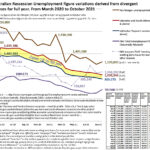
Jobseeker payments shown in the graph vastly outstripped the numbers classified by ABS as unemployed. It makes a farce out of the misuse of ABS’s statistics as a valid measure of internal unemployment. As previously explained, Roy Morgan’s more accurate assessment becomes more evident when ABS plus zero-hours numbers – has of late – been larger than even jobseeker and youth allowance combined.
VACANCIES & JOB GUARANTEES
The question is now, what do poor Job Vacancy measures indicate? There aren’t enough vacancies to cater to the overwhelming majority of unemployed by any measure. This has been the case for decades and is the failure of conservative governments and the private sector. The Government could easily provide a Federal Job Guarantee but is ideologically opposed. Similar opposition was prevalent when Prime Minister John Curtin, postwar, established a not dissimilar mechanism resulting in unemployment remaining beneath 3% in the 1950s and 1960s. Instead, successive governments have diminished the public service by privatisation, undermined manufacturing and “deter investment” in renewables. Ross Garnaut, who produced two Climate Change Reviews for the Australian government, wrote the book “SuperPower”. In it, he notes we have squandered an enormous economic advantage. Worth reading unless you are susceptible to depression at discovering how the “fog of Australian politics” has obscured tremendous economic and employment potential for our country.
SEPARATION OF VACANCIES

This aside, there are two recently diverging measures for job vacancies. The Department of Employment generates the IVI stats for internet job advertisements. ABS does a quarterly vacancy survey amongst businesses. When I first began writing about the anomalies of unemployment stats, the variation between these two figures was negligible enough to be ignored. For example, in 2016, I wrote, “The ABC reported in January that “…newspaper ads rose 0.4 per cent last month, but now make up less than 5 per cent of employment advertising…”.” So I focused on IVI statistics because newspaper advertising, shop windows ads, and private networking recommendations for applicants appeared to be statistically irrelevant.
Increasingly in the internet age, jobs recruitment can occur on various sites: Seek, CareerOne, Australian JobSearch, LinkedIn, Facebook, and Twitter. The problem is that there is no government break-up in the last three like the IVI does for the first three. (Figure:3). However, private recruitment agents, “shop window” ads, or boutique specialist websites are applicable for the local low-skilled workforce expected to find work in rural areas for labour, like fruit picking.
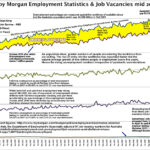
The ABS survey reported smaller numbers than the IVI statistics over a decade ago. That period aside, there was no significant divergence between ABS and IVI until the last four years. You can see the change in Figure 4. While we can’t blame pandemics, it is worth referencing the coincidental timing of the economic falterings discussed initially.
Businesses shifted from under-reporting vacancies over a decade ago to reporting more vacancies than were reported as advertised. This is partly due to recruitment alternatives arising in LinkedIn, Facebook, Twitter, Instagram and Youtube that are not included. The most recognised recruitment platform, LinkedIn, is becoming drastically less popular because of stats on how many LinkedIn profiles are exaggerated and out of date. Despite Linkedin’s internal exaggerations, according to Jobvite surveys, the number of recruiters using LinkedIn has dropped from 92% in 2017 to 77% in 2018 to 72% in 2020 to 65% in 2021.

Pre-pandemic economic faltering in Australia meant companies relied on natural attrition or dismissal to shed employees they didn’t replace, sometimes even modifying the job description to force people out. They overworked the ones they employed, but didn’t want to finance their overtime. This became evident as companies were increasingly being outed for wage theft for unpaid overtime. Corporates lobbied to have conservative governments undercut penalty rates on the spurious claims to pay for more employees. Basic maths reveals this was not applicable for anything but a small number of large companies with significant numbers of employees. (Figure:5) Such companies shed employees when penalty rates dropped, and nobody got more work. So jobs continue to be shed.
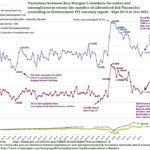
Businesses reported more contingent vacancies than they appeared to advertise, and then the recession hit. Demand bottomed for all but the largest enterprises, people stayed in lockdowns, the economy recessed, and unemployment rose to nearly a quarter of the workforce. Finally, however, its slowly returning status of between 1 to 1.5 million unemployed of 2019 has emerged. From mid-2021 onwards, unemployment settled between 1.2 and 1.5 million. (Figure:6)
There has undoubtedly been higher average unemployment for 2021, but for the last six months, it hasn’t exceeded the boundaries of 2019. So there are – to be fair to the conservative political commentary – grounds for saying employment has recovered to the range of pre-pandemic levels. Just don’t look at the figures (Figure:6) or the relative range too closely.
So now, business is over-reporting vacancies to the ABS that they do not advertise or intend to fill without a demand surge. Yet even advertised vacancies have gone up. (Figure:3/7). So why might specific labour markets be advertising more? Does it represent an increase in new jobs, or does loss of employment markets contribute?
CONSIDERATIONS
Due to international border closures, consider the loss of migrants, pacific Islanders and backpackers coming to Australia – on visa conditions that require rural employment. Consider the access to work of migrants who, out of economic necessity, live in crowded low socioeconomic LGAs with higher exposure to the Covid-19 virus to jobs in external LGAs that had travel restrictions. Third, consider how travel restrictions and lockdowns restricted high-end recruitment that previously used in-person networking meetups or travelling to interview overseas. Fourth, consider that net migration away from cities has accelerated during the recession and remote work opportunities, which has fuelled the rise of alternatives in smaller towns with lower living costs. Finally, consider that the absence of visa workers revealed an entrenched culture of exploitation and inadequate financial compensation in the farming and service industries.
The results of these considerations are two-fold.
- This has generated much of the employer claims that they are “struggling to find suitable staff to fill job vacancies”.
- The realisation that low wages you can get away with for migrants, poor conditions, and exploitation will not be acceptable jobs for Australians. Farmers and Restaurants are now forced to engage with better educated Australians who expect better pay and are more aware of their rights as employees. So it is no surprise they have been less successful in filling jobs.
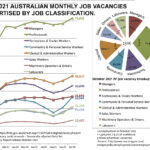
As localised markets for exploitable employees have dried up, businesses have had to advertise outside their LGAs. Figure 7 shows that according to the Department of Employment, rises in advertisements for labour with the only significant dips in recruitment across all industries were during the Covid-19 Delta outbreak. However, this does not necessarily translate as a rise in real jobs. Instead, some portion likely reflects the need to expand advertising into previously unutilised media, with further reach than LinkedIn, Facebook, Twitter, Instagram and Youtube.
Recruitment for hospitality, manufacturing, warehouses, leisure sectors and farming industries relied on a willing pool of locally exploitable, low-skilled, migrant labour on tap. This has vanished for all the aforementioned reasons. Moreover, constrained reach advertising via social media might have limited scope to attract Australians. Many don’t want to work for the exploitative conditions or the low wages on offer.
LAZY AUSSIES
The political and MSM dialogue to cover the exploitation hasn’t changed in years. “Lazy Aussies just don’t want to work” was an excuse to hire cheaper, exploitable 457 visa migrants when Abbott was PM. Under Morrison, “Laziness” and “JobSeeker is too generous” are the absurdities brought to bear. These diatribes never address the wage rates or the conditions, and employers will lie about them, while politicians facilitate labour exploitation. Corporate Australia seeks to frame this as a “labour shortage”.
In contrast, the ACTU and other Unions call it a living-wage shortage, a hazard pay shortage, a childcare shortage, or a shortage of non-discriminatory, non-toxic management. So instead of being responsive to the needs of Australians in a time of crisis and expanding public sector employment, welfare or active labour market policies, the government are facilitating a gig economy. One complete with exploitation and underpayment and ensuring labour mobility and wage growth are at an all-time low.
MONEY FOR MATES!
In the face of a recession, the recent history of record-breaking under and unemployment levels, stagnating wages, a surge in the part-time and gig economy, the Liberal Party’s solution is support for bringing “up to 160,000 foreign workers and students a year into Australia”. So how do they facilitate this amid a global pandemic? Via a private quarantine scheme recommended by DPG Advisory Solutions, “linked to former deputy NSW Liberal Party director Scott Briggs”. The scheme “was awarded a $79,500 “limited tender” contract by the Home Affairs department to provide “consultancy services”. Also, the founder and director of DPG is David Gazard. A close associate of Scott Morrison and former ministerial adviser. The Department of Home Affairs chose these private quarantine reviewers without government tender.
This is the quality of solution for a federal government that had till now avoided building quarantine facilities, as “carefully vetted” consultants are brought into resolving the issue of businesses – who, despite massive unemployment numbers – are “struggling to find exploitable employees”. This deliberately cast illusion of economic prosperity hides the poverty suffered by millions in Australia and is challenging to maintain with the recent GDP drop – the largest on record. It leaves real solutions of federal job guarantees, active labour market policies, and adequate welfare support in the dust. Is this the land of the “fair go” we want Australia to be, or is that just a myth we abandoned generations ago, if indeed such an ethos ever existed?